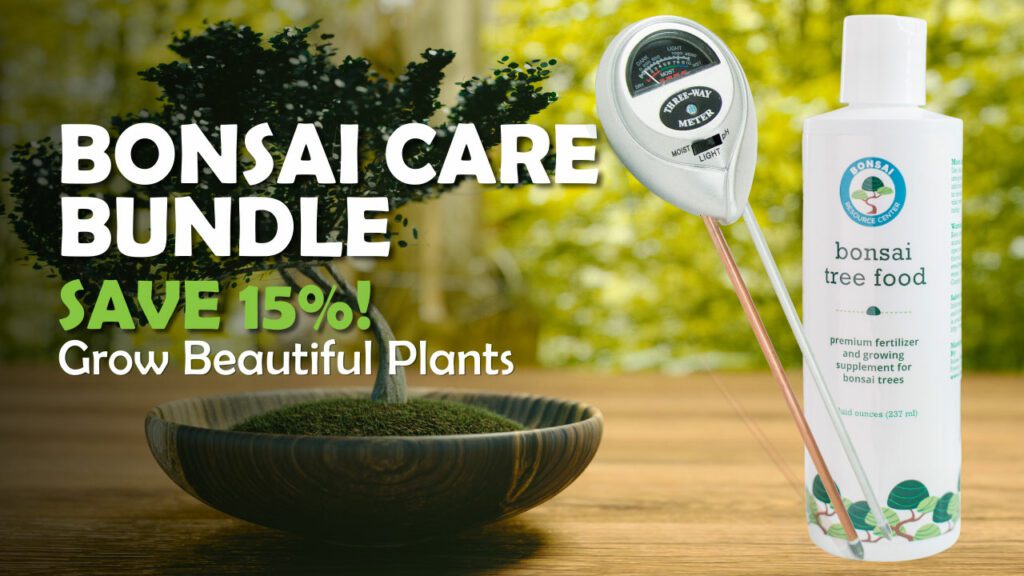Chances are your new bonsai habit practice has introduced you to a lot of new lingo. But you don’t need to bust out your biggest dictionary to understand basic bonsai meaning and practices. This glossary of common words and terms will do the trick. Let’s dive in!
1. Bonsai Tree Meaning: What Is a Bonsai Tree?
Bonsai: A bonsai plant is an ornamental tree or shrub grown in a decorative pot and artificially prevented from growing to its natural size.
Bonsai is a Japanese art form derived from penjing, an ancient Chinese practice that uses dwarf trees to create miniature replicas of the natural world. The key difference between the two is that bonsai incorporates the principles of Zen Buddhism by removing all secondary elements. The primary purpose of bonsai is to create a tree that exemplifies simplicity, balance, and harmony.
Bonsai Meaning in Japanese
Literally translated from Japanese, the term “bonsai” means “planted in a container.” (Makes sense!)
Now, let’s take a look at some other terms you may encounter as you dig deeper into your bonsai practice.
2. Bonsai Tree Meaning: Tree Types
- Broadleaf: Trees or shrubs with broad, flat leaves that go dormant from autumn until spring. Most, but not all, broadleaf trees are deciduous.
- Coniferous: A tree that bears cones and needle-like leaves that are typically evergreen. Typical examples include cedars, firs, junipers, spruces, and yews.
- Deciduous: A tree or shrub that sheds its foliage in the fall and grows new leaves in the spring. Typical examples include oak, maple, beech, and elm.
- Evergreen: A plant with foliage that remains green and functional through more than one growing season. This term is commonly used to describe coniferous trees, but also applies to warm-climate plants that do not drop their leaves for the winter season.
- Fruiting: A tree that bears edible fruit—the part of the plant that carries the seeds.
3. Bonsai Tree Meaning: Care Terms
- Back budding: Pruning terminal buds (at the tip of a stem or twig) to encourage growth further down a branch or trunk.
- Deadwood: A technique used to create, shape, and preserve dead wood on a bonsai tree to replicate the appearance of aging.
- Defoliation: Removing most or all of a bonsai’s leaves, forcing the tree to grow smaller, denser foliage in its place.
- Grafting: Horticultural technique used to fuse a branch or shoot to the stump of a tree. Grafting only works with trees of the same species.
- Pinching: A technique used in bonsai cultivation to control the growth of new foliage by removing soft shoots with the thumb and forefinger.
- Pruning: Cutting back roots, shoots, and branches to direct and control your tree’s growth and shape.
- Repotting: The practice of taking a pot-grown bonsai out of its container to perform root care and introduce fresh soil.
- Wiring: A technique using wire to bend and reposition a tree’s branches to shape the direction of new growth.
4. Bonsai Tree Meaning: Key Plant Terms
- Advantageous bud: Any plant growth sprouting from a different place than it normally would.
- Apex: The very top branches or highest point of a bonsai tree.
- Callus: Thick, bark-like tissue that forms to seal a wound where a tree has been pruned.
- Canopy: The foliage extending farthest from the tree on the uppermost, outward reaching branches.
- Cambium: Fresh green tissue just beneath the bark that causes growth in the circumference of the plant.
- Crown: Upper part of a tree where the branches reach from the trunk and define the shape of your bonsai.
- Node: A growth point on a branch or trunk from which leaves, leaf buds, and shoots sprout.
- Old wood: A twig, branch, or stem that sprouted in a previous growing season.
- Petiole: The stalk of a leaf where it attaches to the stem.
- Root ball: The mass formed by the roots of a plant and the compacted soil surrounding them.
- Xylem: The water- and energy-conducting tissue below the cambium layer in a tree trunk.
5. Bonsai Tree Meaning: Classification Terms
- Genus: A unit of classification used to group various species of plants that belong to the same family. They share the first part of the plant’s Latin name. (Ex. Juniperus californica, or California juniper; Juniperus communis, or Common juniper)
- Kabudachi: A tree with two or more trunks extending from its foot. Wide trees with multiple trunks are sometimes called “netsuranari.”
- Neagari: A style of bonsai featuring a tree with exposed roots to represent erosion by mudslide or rain.
- Mame: A size classification used to describe hyper-miniaturized bonsai of 4 inches (10 centimeters) or less in height.
- Moyogi: A term used to describe a bonsai with visible curves in its trunks and branches, also known as “informal upright.”
- Pre-bonsai: A term used to describe a young tree that has not yet been cultivated into bonsai.
- Shakan: A style of bonsai featuring a tree with a slanting trunk to represent growth in the harsh elements of nature.
- Species: A subgroup within a genus that classifies closely related trees with similar characteristics. Species is indicated in the second part of a plant’s Latin name.
- Variety: A subdivision of species defined by one or more varying characteristics. Variety is indicated in the third part of a plant’s Latin name.
- Yamadori: A tree collected from nature that remained small due to natural circumstances.
Have more questions about bonsai meanings and terminology? Start a conversation in our Facebook group.
Bonsai With Us!
The Bonsai Resource Center is here to help you learn the best bonsai tree care and provide you with the tools you need to keep your tree healthy and strong. Explore our other articles, visit our online shop, and connect with other bonsai lovers in our Facebook group to learn everything you need to know about this rewarding hobby!
More Bonsai Tree Care Resources
The Ultimate Bonsai Plant FAQ Cheat Sheet
The Only Bonsai Tree Care Calendar You’ll Ever Need



